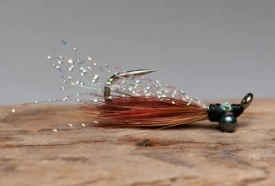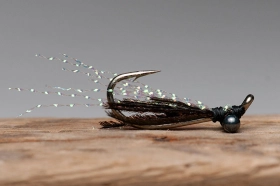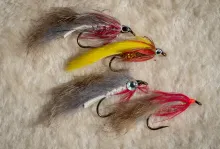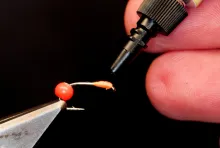A slight variation of an really old fly of mine, which again was a derivative of Bob Nauheim's famed Crazy Charlie. It's simple and really mundane, and simpler than the already very simple original!
I tied this fly many years ago, and have dug it out again because it's a good and very easy fly to tie - and it produced fish back then and can do so again in its mundane version - which is actually very much like the original...
A Crazy Charlie derivative
It is essentially a Crazy Charlie variation, and I won't try to hide that fact. That classic bonefish fly has been the inspiration of a ton of flies, and when I tied the first Crazy Dane it was also inspired by Bob Nauheim's fantastic fly. On the other hand you will never be able to tie a fly with eyes and an upside down wing, that won't be declared a copy of Bob's original fly.
The Crazy Charlie is a suggestive pattern that was originally supposed to imitate a glass minnow, but has been tied and fished as shrimp and crab imitations as well.
But I wanted something that was just a glassy and really simple, pelagic baitfish.
Back then I tied it on a larger and thinner hook, I left out the tail but kept the body using tinsel and larva lace in stead of the mono used on the Crazy Charlie, and I tied flash on top of the wing rather than the calf tail or hackle wing that was found on Nauheim's original, which was called the Nasty Charlie when tied with hackles or the Crazy Charlie when tied with calf tail.
Same, same, but different
For the latest generation of the Crazy Dane I haven't actually changed much compared to the first ones I tied more than 10 years ago, which already played very well with the idea of simplifying patterns to become mundane. I have left out the body. It looks good on the original, but loosing it has only changed the fly a bit.
I have also scaled down the hook and now use the Kamasan B175 that I have vowed to use in my mundane flies, but a larger and just as accessible B170 would get it closer to the first ones I tied many years ago. For this pattern I want the weight, so B175 it is and a size 6 is fine for the size of fly I need the most.
Wing options
I used the ever present golden pheasant for the first flies I tied. That was what I had, and it added exactly that bit of color that I wanted to suggest gills, intestines or just a dash of arbitrary red.
In some later variations of this pattern I have opted for the just as useful peacock herl, which in my eyes adds to almost any saltwater fly and is a natural choice for this type of fly. I simply pluck a couple of herls in bits to get the right length of wing.
If you want, you can easily exchange the GP feather or herl for some kind of hair, Arctic fox, bucktail or what you have or like. Hackle fibers can also do, chickabou or even marabou.
In keeping with the simplicity original Crazy Dane I stick to the GP 90% of the time.
|
|
|
|
|
|
|
|
|
|
|
|
|
|
|
|
|
|
|
|
|
|
|
|
|
|
|
|
|
|
Fishing the fly
My original was made for fishing in open and deeper water.
I still tie some Crazy Danes, especially now where I fish from a pontoon boat all the time and cast over deeper water as well as trolling flies more often, just as I did back when I developed the Crazy Dane for my belly boat fishing in open, clear water.
These flies should be fished on a sinking or at least intermediate line. The fly doesn't weigh much and is easy to cast even on a light rod. You may think that sinks pretty slowly, but thanks to being as sparse and slim as it is, it penetrates the water easily and does get down.
I also simply troll the fly while sailing. It's very visible and can attract fish on a fair distance even in unclear water. Pulling the fly fast through the water or trolling it, induced some surprisingly violent and wonderful strikes back when I started using it.
It's supposed to fish upside down and will if it's tied as prescribed. It sinks with the hook point up thanks to the placement of the "wing" and won't snag easily if you strike weed or rocks on the bottom.
Hand picked for this article
- Log in to post comments





































